
The 4x4 world is obsessed with the latest and greatest. We have to have the newest gear, the brightest lights, the most elaborate awning you could conceive. We’re desperate for an extra 5hp at the rear wheels, no matter how much power we had originally anyway. People line up out the door when a manufacturer releases a new model, the upgraded cupholders too tempting to ignore. It’s been a slow change, one few people have noticed, but while 4x4s used to be built late at night in the garage with mates, they’re now built online one Afterpay order at a time.
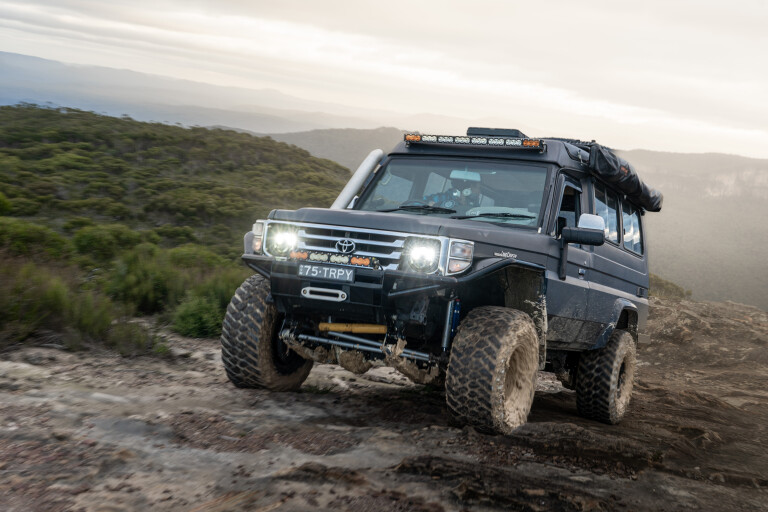
But deep in the back country, far beyond the reaches of 4x4 fast fashion, hard graft is still piecing together some of the coolest builds on the tracks. Ryan Kestle’s unbelievable 75 Series Troopy is one of them.
Rolling off the production line way back in 1989, Ryan’s HJ75 Troopy has been sculpted from the ground up into his perfect adventure machine. Starting from the chassis up, the Troopy’s front and rear diffs have been relegated to the scrap heap, a matching set from a 60 Series Cruiser now live in their place. The near identical units bumping the Troopy’s track width out around three inches front and back. Both axles are sporting Harrop ELockers for maximum traction, and they’re wrapped around 4.3:1 Nitro ring and pinion sets front and back.

SUSPENSION TWEAKS
Rather than chasing lift with an off-the-shelf suspension kit, Ryan has massaged the Troopy’s suspension on the hunt for flex and ground clearance. Up front Ryan’s sourced a pair of rear EFS two-inch lifted leaf springs designed for an FJ60, then spun them around backwards. The factory mounts have been tweaked to improve the shackle angle for maximum articulation. While the welder was out, the factory shock towers were extended, allowing Ryan to make the most of the Superior Engineering 2.0 12.5-inch travel Remote Reservoir Shocks.
Up the back, a second set of two-inch lifted EFS springs designed for a 75 have had their total leaf count reduced with the load leafs removed. The result is less load-carrying capacity, but a smoother ride and improved articulation.

Eagle-eyed readers will spot high-clearance U-Bolt plates front and rear, helping claw back valuable ground clearance. The entire affair has allowed Ryan to squeeze in a set of 33-inch Maxxis RAZR mud tyres around 15x10-inch steel wheels, the DBA rotors hidden well within the-44 offset.
LONG LIVE THE KING
If you’re not a Toyota fanatic, you’d be forgiven for not understanding all the fanfare over the trusty 12HT. From external appearances, it’s a bit of an oddity. A big straight-six turbo-diesel putting out comparable power and torque to the 80 Series’ naturally aspirated diesel. So why is it still held in high regard more than 30 years since the last one was built?

Put simply, it’s a bridging motor. Way back in the ’80s, it was leaps and bounds ahead of its time. Longer piston skirt than the outgoing 2H, direct injection, a clever glowplug-less design, and oil squirters on the pistons meant it was worlds above everything you could buy up until then.
The opposite is also true. Right after the 12HT, Toyota went to far more complex motors. Overhead cams. Timing belts. More susceptible to bad fuel and more mechanically complex. The 12HT is seen as the last of the mechanically simple and reliable motors, and the first of the big power and easy driveability motors. It’s not hard to see why they’re so sort after even today.
ENTER 12HT
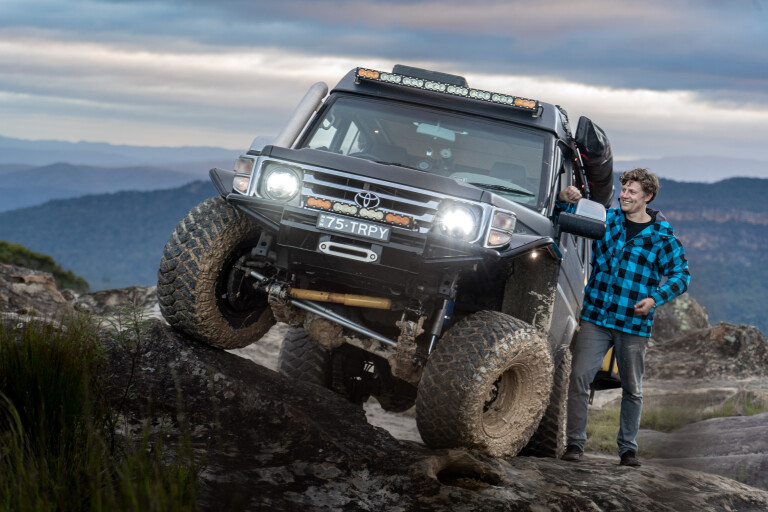
Pop the bonnet of the 75 and you’ll find an old-school diesel, but not the one you expect. One of Ryan’s first jobs when the near stock 75 rolled in to his garage was to update the lethargic 2H diesel. Making 107hp and 240Nm 33 years ago when it first fired in to life, it’s barely enough to keep up with traffic these days. In its place now lives the widely regarded 12HT Toyota factory turbo-diesel. Making 134hp and 315Nm from stock, it was capable of handling the extra horsepower Ryan was going to wring out of it.
Breathing through the handmade four-inch aluminium snorkel, a G-Turbo Green Wheel set-up hoots and hollers on the dyno, all the way up to 176hp and 550Nm at the wheels. A handful of supporting mods help it in this endeavour, namely the three-inch straight-through exhaust, K&N high-flow air filter and the Ryco Fuel Water Separator.
BAR WORK
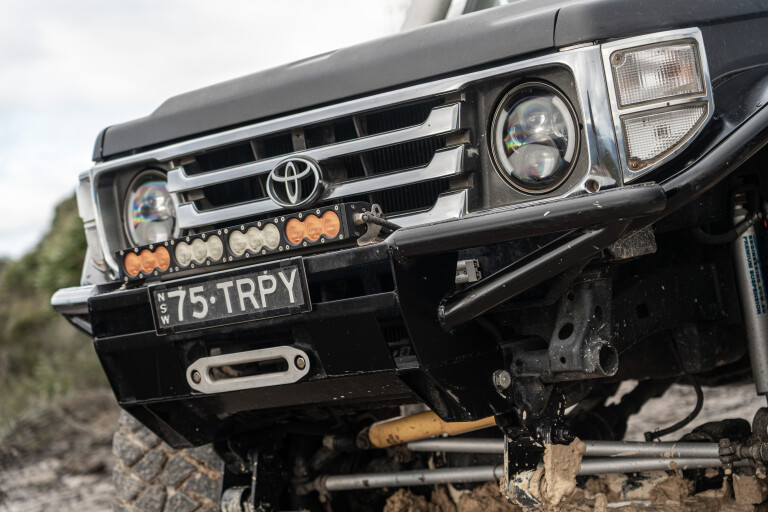
Back up on solid ground and the Troopy’s exterior has had even more of an overhaul than the driveline and suspension. Protecting the too-good-to-be-true Raptorliner coating is a series of custom bar work from front to back. Up front, a hand-built winch bar tucks in high and tight to the Cruiser’s body, a later model HDJ79 grille sneaking in behind the eBay special LED light bar.
Moving down the flanks and the entire front guards have been replaced. While the purists might look away in horror, the custom tube guards allow Ryan to take on any track without worry of crumpled sheet metal. Likewise, armour plating along the flanks lets him run without traditional rock sliders. And the rear quarter panels have been chopped; a raised rear bar now lives in their space and houses not only the spare tyre high and tight, but three jerry cans, complete with a skid plate underneath them.
TRAKKA TOP

Up top, a hint of the Troopy’s age shines through for those who know what they’re looking for. A pop-top conversion from Trakka replaces the Troopy’s tin-top with a lightweight fibreglass unit that easily lifts allowing full standing room inside. Attached to the side is a Darche 270-degree wraparound awning as well as six Stedi LED exterior lights around the perimeter. The roof itself houses an Ocam Roof Rack and Caos Roof Box, for additional storage.
INTERIOR FIT-OUT
Moving to the inside and that hands-on DIY craft shines through even further. Starting from the rear, the Troopy’s barn doors have been recessed in, allowing for two Frontier Lines folding camp chairs and a Jetboil stove to tuck inside. The full-length internal panels also provide storage, as does the 150L pull-out drawer with stainless-steel prep table. Food and drinks are taken care of with an Evakool 75L dual-zone fridge-freezer up the back, and a Waeco CDF11 centre-console fridge up front. A full-length bench runs along the left-hand side, allowing Ryan to work on the road, while a Trakka two-person bench seat to the right folds down flat so his young fella can sleep there while dad’s up in the pop-top bed above.
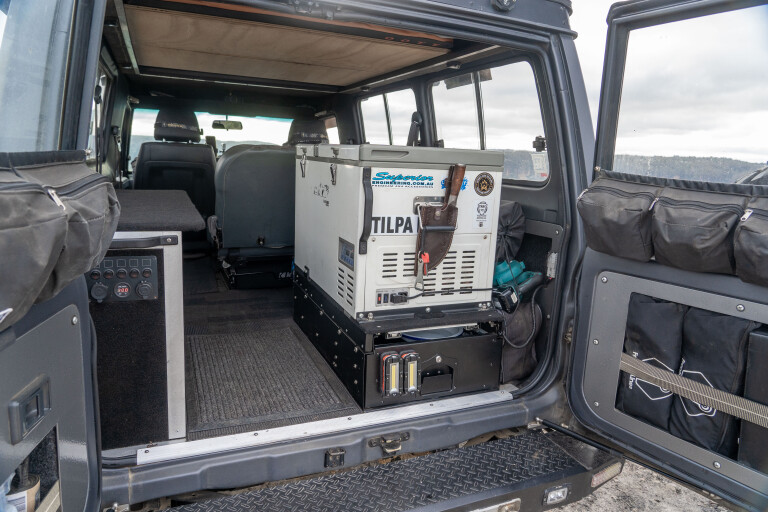
A simple 12V set-up keeps everything running late in to the night. A Ctek D250S up front serves as a solar regulator for future mods, with a Baintech 110amp/h standalone lithium set-up out back. It feeds in to a 2000W pure sine wave invertor and more USB outlets than you could count on both hands.
Up front in the captain’s seat, both front pews have been replaced with leather units from a BMW 320i, of all things. They bolt in tight on Huracan mounts, while a Prado steering wheel updates the forward vision. While the outside of Ryan’s Troopy is striking, it’s the inside that shows real attention to detail. From the clever canvas storage to the adjustable throttle dampener and to dial-in pedal feel, it’s unbelievable just how thorough this build is.
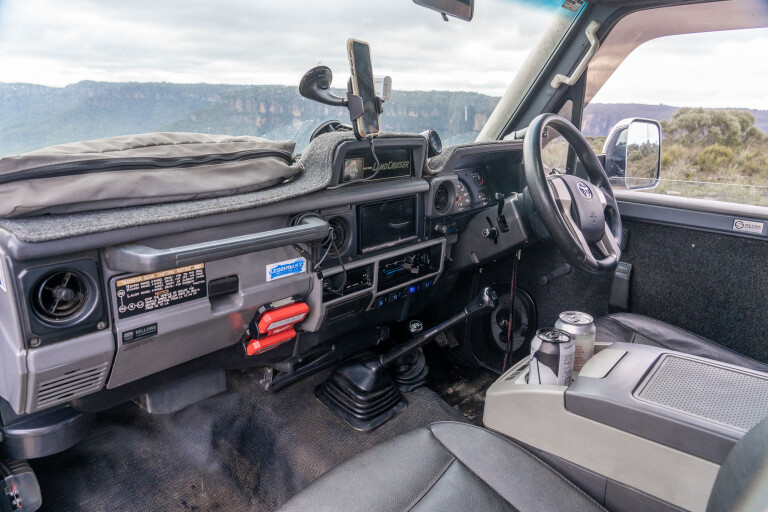
Like most car enthusiasts, Ryan constantly ebbs and flows between wanting to sell it to move on to the next project, or wanting to fully rebuild it. By the time you read this it could be parked up in a rich sheik’s private collection, pulled apart in the shed with a 200 Series LandCruiser chassis underneath, or hopefully trundling along the tracks for another 33 years making memories for Ryan.

COMMENTS